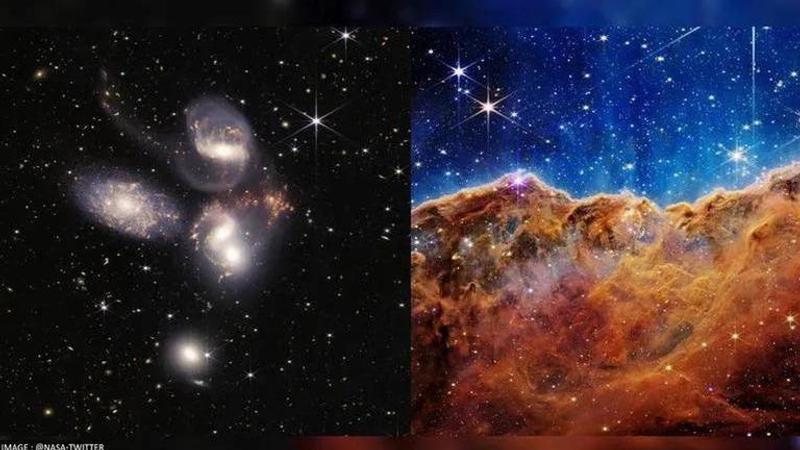Published 22:26 IST, December 17th 2022
Year in review: James Webb Space Telescope's best images released in 2022
The James Webb Space Telescope launched atop the Ariane 5 rocket from the Kourou spaceport in French Guiana on December 25, 2021.

It was July 12 when the James Webb Space Telescope (JWST) began unfolding the universe after six-months of commissioning. The $10 billion observatory launched atop the Ariane 5 rocket from the Kourou spaceport in French Guiana on December 25, 2021 after almost two decades of construction.
According to NASA, Webb's construction began in 2004 and the engineers focused on developing the telescope's mirrors in the years that followed. By 2019, final assembly and testing was conducted to ensure that Webb will perform its deployment and operations flawlessly in space. The telescope has been developed after key contributions from the European Space Agency (ESA), the Canadian Space Agency (CSA) that worked in collaboration with NASA.
Named after former NASA Administrator James Webb, who led the development of the Apollo Program, the telescope is installed at the second Lagrange Point (L2), roughly 25 lakh kilometres from Earth. Webb is designed to observe the universe in infrared, the wavelength of light which is not visible to the naked eye but can be felt as heat.
In just six months since it came alive, the telescope has delivered eye-watering images of the universe as well as of the planets in our solar system through its extremely sensitive infrared instruments. With the telescope nearing its first launch anniversary and as 2022 comes to an end, let us take a look at the best images released this year.
Webb's deepest view of the universe (SMACS 0723)
This image is Webb's First Deep Field, formally known as the galaxy cluster SMACS 0723, that features hundreds of galaxies, some almost as old as the universe itself. Released by US President Joe Biden on July 12, this 'deep field' image covers the sky area of a sand grain held at arms length and is highly distorted due to the phenomenon of gravitational lension. According to NASA, the infrared light from some of the galaxies reached Webb after emerging shortly after the big bang which occured roughly 14 billion years ago.
The Stephan's Quintet
The Stephan's Quintet is a group of five galaxies and they were seen in exquisite detail thanks to Webb's unmatched infrared capabilities. Located 290 million light-years away from Earth, this compact group was discovered 1877 and according to NASA, four of its five galaxies are locked in a cosmic dance. Interestingly, this new image contains over 150 million pixels and covers about one-fifth of the Moon’s diameter.
The Carina nebula
This image features of the most intriguing cosmic feature in the observable universe and is a star-forming region called NGC 3324 in the Carina Nebula. Called ‘cosmic cliffs’, this three-dimentional picture of the nebula has a gaseous cavity at its ‘mountainous’ edge where the tallest ‘peak’ is about seven light-years high. This star-forming region lies about 7,600 light-years away in the southern constellation Carina and is listed among one of the largest and the brightest.
The Southern Ring Planetary nebula
The Southern Ring Nebula is located nearly 2,500 light-years away from our planet and it has been presented in the most detailed form ever with Webb. The telescope's powerful infrared eyes brought a second dying star into full view for the first time, as seen in the image on the right. Moving forward, astronomers will try to dig into many more specifics about planetary nebulae like this one to refine their knowledge of these objects.
The Cartwheel galaxy
Released in August this year, this picture features the Cartwheel galaxy which lies roughly 500 million light-years away in the Sculptor constellation. This galaxy, according to NASA, was an average spiral galaxy before it collided with a smaller one over 400 million years ago. The proof of the collision is in the shape and structure of the galaxy which sports a large colourful ring surrounding a dense and bright inner ring.
Magnificient Jupiter
Webb won the internet when NASA released the pictures of Jupiter in August after its observations in infrared wavelength. The telescope used three specialised infrared filters of its NIRCam (Near Infrared Camera) and was able to spot auroras on the gas giant's poles. Webb's senstitivity to infrared light can be understood by the fact that it even spotted rings around Jupiter along with its two Moons.
Ghostly Neptune
After Jupiter, next on target was Neptune which was presented in a new light and that too with rings. Thanks to Webb, scientists got the clearest view of this ice giant for the first time in over 30 years. Apart from the rings, seven of Saturn's 14 Moons were also visible in the image. Among these seven, Triton is the brightest in the picture due to its atmosphere composed of condensed nitrogen which reflects an average of 70% of sunlight and thus is outshining Neptune.
The Pillars of Creation
The 'Pillars of Creation' was one such cosmic object every one was eager to witness iconic feature through the eyes of Webb through two different instruments- the NIRCam and the Mid-Infrared Instrument (MIRI). This riveting scene was first imaged by the Hubble Space Telescope in 1995 and revisited in 2014 along with several other observatories. NASA said Webb’s new view of this feature will help researchers revamp their models of star formation by identifying far more precise counts of newly formed stars, along with the quantities of gas and dust in the region.
Updated 22:26 IST, December 17th 2022



